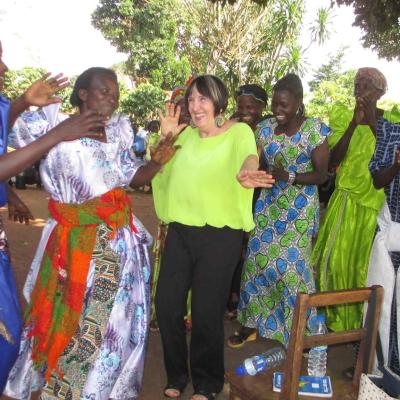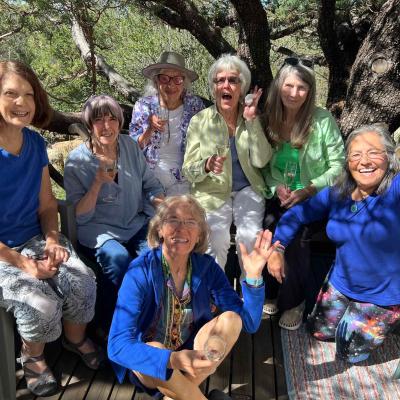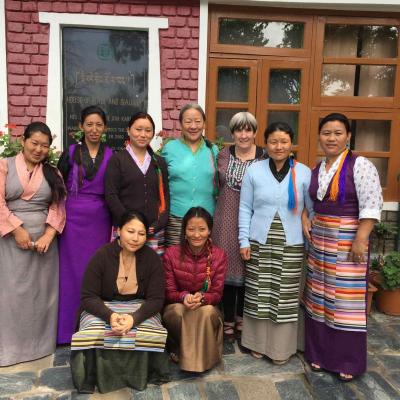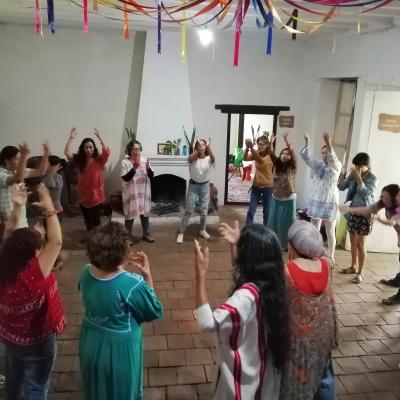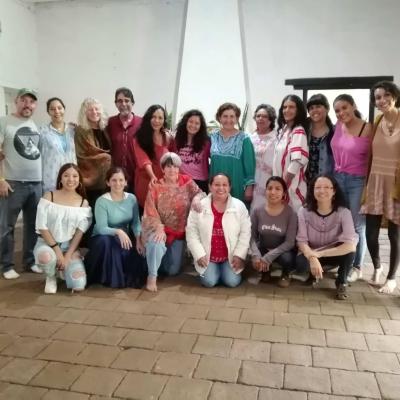Mijares, S. (Fall 2017). The archetypal presence of time. Coreopsis: Journal of Myth and Theatre. Autumn 2017 Vol. 6 Number 2. The Philosophy and Art of Ritual Creation. Peer Reviewed Journal of The Society for Ritual Arts ISSN 2333-0627
NOTE: This is not the finalized published version as it had minor edits.
The Archetypal Presence of Time
© 2016 Sharon G. Mijares, Ph.D.
Abstract
Time is a concept with many theories and mythologies attempting to define it. Quantum mechanics theory suggests it is an illusion, whereas most of humanity measures time by past and future—concepts related to cyclic periods of time. It appears that both theories are correct, and that these dimensions intercept with one another. Carl Jung’s theory of archetypes of the collective unconscious suggests that archetypal forces exist independent of a theory of time.
These dynamisms emerge from inner realms, influencing our third-dimensional lives. Cyclical time itself can be interpreted as archetypal influences containing elements of past, present and future. A Western theory of time is associated with Astrological Ages. Each age manifest new religious ideas as well as radical religious movements desiring the destruction of prior belief systems and related antiquities. We live in an era in which past, present and future converge. Despite the numerous end-time theories, this theory of ages, governed by the movements of the cosmos, suggests the continuation of life on earth. But in order to fully move into the next new age, we need to unite with multiple dimensions of the archetypal presence of time. Ancient archetypal energies motivated human beings to develop civilizations and to create great antiquities and related mythologies. It was a response to the forces of heaven and earth. These ancient times should be both cherished and protected, as they will empower both the present and future.
The Archetypal Presence of Time
Introduction
We define our days and nights by time. Our lives are, in fact totally organized by it. Historically, humanity tends to both glorify and denigrate it in attempts to memorize or to destroy any significance of past memories. Many individuals and groups are also apprehensive about the future—primarily because it is yet unknown.
One Western theory of time is associated with Astrological ages, a paradigm concerned with archetypal, mythological forces. This paradigm also helps define the destructive impulses prompting the attempts of some religious groups to destroy antiquities providing evidence of a past. It also indicates that humanity will survive the impending threats of environmental and nuclear destruction.
This article focuses on the various dimensions of time, and the archetypal characteristics given to it. We live in an era (a time) when there are extremely divisive beliefs and related destructive behaviors, as well as intimations of profound creative and powerful glimpses of a new era—unlike any epoch before it. For example, knowledge of all the world’s religious and wisdom traditions is easily assessable for spiritual development, internet technologies have opened the doors to greater knowledge, holistic healing modalities are more easily obtained as ancient and modern technologies expand opportunities for healthier lives, and intimations of the expansion of space travel are manifesting by the month. Yet in the midst of the promise we see the demise. Destructive behaviors surround and compete with the progressive, life-affirming ones. What motivates various groups to destroy ancient creative, sacred and historical manifestations? It is possible to examine the deliberate destruction of ancient sacred sites from an archetypal perspective related to the passage of time.
Despite the human relationship to time and its varied attributes, it has been found that the way we perceive time as past, present and future does not exist. In fact, science cannot validate exactly what is occurring in this present moment according to our traditional ideas about progressive time. But what is the nature of our consensual relationship to time as it also appears to be quite valid?
Cyclical Time and Archetypal Forces
According to many religious ideals, life is a manifested dream. The Vedic scriptures relate how Brahma dreamed the world into being. These same scriptures discuss various ages-- cyclical periods of time. For example, according to Vedic beliefs about human eras, we currently live in the Kali Yuga age lasting about 432,000 years. Greek mythology also noted four ages. For example, its golden age ruled by the god Saturn (or Chronos) represented lost innocence, as well as the loss of idyllic childhood and paradise.
Most religious and spiritual cultures have beliefs about creation and its relationship to time. The indigenous of the Sierra Nevada de Santa Marta believe that the Great Mother “spun her thoughts and conceived the nine layers of the universe (Davis, 2009. p. 143). Such indigenous and shamanic perspectives are significant as they represent the world’s oldest philosophical and spiritual belief systems. Their ancient relics and sites relate stories of earlier times and provide evidence of life and thought of previous eras.
Western metaphysics has its own model of the passages of time that is determined by astrological ages lasting approximately 2,000 to 2,500 years. Many people have heard of the coming Age of Aquarius, but are unaware of the history of this concept. I will be using this metaphor for time periods to provide greater meaning to events taking place that impact past, present and future. When examined, these archetypal experiences of time seem to be very real,but, according to the science of quantum theory, one that seeks to explain the relationship and behavior of energy and matter, the accepted version of time as we experience it is an illusion. The Illusion of Time
The question of time, its beginning as well as its end, has been and remains a topic of deep religious and scientific inquiry. In 2011 Scientific America devoted an entire edition to this topic with the title “A Matter of Time.” Much of humanity holds its schedules according to a mechanical clock, assuring we meet production deadlines and performance goals, but many new revelations are emerging as explorations continue to explore this topic. One practical example, that Scientific America editor Gary Stix provides concerns the emergence of the internet. He explains that “in internet time, everything happens everywhere at once. [and] Time has triumphed over space” (2011, p. 6). Numerous scientists are pursuing answers to the question of time as an illusion as well as our perceptions of and about it.
According to String Theory the Big Bang theory as a “beginning” may well be an illusion. Proponents of this belief dispel the idea of a beginning and replace it with the idea that it was the “outcome of a preexisting state” (Veneziano, 2011, p. 79), proposing the theory that it was more of a transition than a beginning. Veneziano believes that, “inside a Black Hole space and time swap roles. The center of the Black Hole is an instant in time” (p. 87) and “vestiges of the pre-bangian epoch might show up in galactic and intergalactic magnetic fields” (p. 89). Other scientists, have developed a theory of Loop Quantum Gravity, theorizing that time and space appear in “discrete pieces…or lumps” (Smolin, 2011, pp. 95-96). Although Smolin admits they could be proved wrong, he and colleagues agree that Loop Quatum Gravity allows for further questions and further explorations that are leading toward greater understanding of the question of continuous time as opposed to its beginning. In examining its “mysterious flow,” Theoretical Physicist and Cosmologist Paul Davies notes that “the passage of time is probably an illusion. Consciousness may involve either thermodynamic or quantum processes that lend the impression of living moment by moment” (2011, p. 8).
Despite these emergent theories concerning time, it appears that immense creative forces far beyond our current understanding were present as the universe manifested. Even though scientists differ in their theories about the process of creation, all of life contains a creative impetus at the core of every atom and cell within all of its being. A cell divides and multiplies. The seed becomes a tiny plant that finds a way to grow toward the sunlight from a crack in the cement. The process of self-emergence is a potential within all life. This creativity also continues influencing dreams, visions and goals at personal as well as global and universal levels in some strange movement—a progression of time.
What About Consensual Experience: Shared Time?
From the individual and cultural perception it appears that inner and outer realities are streaming through life. From subtle inner realms, Archetypal energies continuously influence and motivate human behaviors. The late Carl G. Jung (1875-1961) wrote extensively on the topic of archetype and archetypal forces (cite) manifesting in dreams, art and universal mythologies.
Jung believed these forces to be archaic patterns taking form from the universally-shared collective unconscious.
These prehistoric forces motivate great love, rage as well as heroic endeavors manifesting in ordinary life experiences. Likewise, the mythologist Joseph Campbell (1904-1987) validated these forces manifesting throughout human mythologies (2008), found in indigenous and religious stories throughout the globes. In some mysterious way, human beings are linked in what appears to be an ongoing mythological journey— filled with both terror and delight.
According to Jungian analyst Dr. Michael Conforti archetypes and fields influence one another. In fact, he theorizes that “the energetic component of an archetype, which exerts its influence over space and time,” (p. 22) is evidenced in dreams and transformative experience. This article explores the relationship of archetypal time in both inner and outer realms of existence. They are particularly evidenced in the mythologies defining the passage of time, from the Greek Mother Goddess Demeter mourning the loss of her daughter as her sorrow becomes the season of Winter to the Astrological definitions of Ages and so forth.
Dream-like energies have the potential to effect change within this third-dimensional realm. The same process of archetypal influences impacting both life-affirming development and creative change can be seen in destructive behaviors manifesting in events taking place within this world we share. Many might agree that much of the current state of affairs taking place is akin to living in a nightmare.
Architectural and Creative Representations of Time: Metaphors for the Past
Creative change is often the result of a paradigmatic shift that occurs from an inner level of consciousness toward an outer manifestation. We live in a world filled with possibilities, and yet it appears as though it is on the brink of destruction.
From this perspective we can also see that archetypal influences prompt a civilization to create architecture, art, ways of communicating and knowing. We are collectively influenced by archetypal dream images manifesting into physical reality—taking form. There are historic examples of this manifesting in the architecture of early Egyptian temples portraying the gods and goddesses in equality. This was also true in early Mayan of central Mexico and the pre-Incan culture of Tiwanaku in South America. Archetypal ideas of gender, light and dark (sun and moon), as well as human personality attributes associated powers observed in animals, birds and fish. These forms take shape representing inner realities. Replications of inner consciousness can be found in every nation, continent and island, from Asia to Africa to the Americas. Peoples of ancient times portrayed their stories in archetypal structures--engraving myth and history into stone. Religious movements are also motivated by archetypal influences manifesting into belief systems—for better or for worse.
Recognizing the Importance of Relating With and Learning from the Past. Several years ago I began traveling to ancient sites, particularly those in Mexico and South America, to embrace the creative energies and sacred ruins depicting ancient times. I also realized I was doing the same thing with nature and its elements. This realization occurred as I was planning to visit various cenotes (Mayan water pits/sinkholes) in Yucatan, Mexico. The year before I had gone to the lowest body of water on the earth, the Dead Sea, and one of the highest, Lake Titicaca. Unconsciously, I was being led to various bodies of the element Water. Around this same time, an Egyptian friend and colleague, Dr. Aliaa Rafea, began organizing a team of specialists to meditate on early beginnings in ancient Egyptian sites. Rafea and her Assi Wa Wassi team believe that these places still emanate the archetypal energies present as the civilization emerged. It gave me a language for what I had been doing the last eight years in Latin America. We were both connecting with original archetypal dream-like substances—life energy-- present as these civilizations emerged.
I learned that this awakening was occurring in other places as well. For example, Yumiko Otani, a Japanese woman, has been introducing ancient Shinto myth and teachings, connecting past and present in how we grow and eat our foods (Otani, 2014). She believes this will create a healthier humanity and future.
A movement began in Costa Rica where a growing group of professionals from all fields began meditating its early beginnings. They were questioning its archetypal purpose and why they had chosen to move there. No doubt this is occurring in many places throughout the planet.
These movements are motivated with recognition of the relevance of being present with ancient roots at the same time that we are present in this era. This then facilitates openness to new influences from the future. If scientists propose that “time is an extra dimension akin (but not identical) to space” (Davies, 2011, p. 9), then one can see how this is possible.
Movements Attempting to Destroy the Past: In this present era, according to our ideas of the passage of time, the earth, including all of its’ species, are threatened by environmental disaster, corporate greed, destructive religious beliefs, and other social influences. Our creative and sacred past is also threatened by the ignorance of those who lack reverence for religious ideals and expressions differing from their own. Their intent becomes one of destruction based on fear and limited knowledge. The question arises: Why are fundamentalists of prominent religions destroying historical sources of archetypal power?
This is not new as in Exodus 32 (Jewish Torah and Old Testament) we read of the Jewish prophet Moses destroying the golden calf, idols of earlier pagan cultures. There are also images of defaced carvings in temple pillars enacted by early Christians evidenced in ancient Egyptian temples. Dynamite and bombs did not exist so early Christians must have spent countless hours defacing these holy representations of memory.
· The United States coalition focused on bombing of Iraq following the attack on 9/11 ignored the damage being done to ancient Sumerian sites and its icons. Its focus was more on obtaining control of oil reserves.
· The Taliban dynamited huge Buddhist statutes carved in Afghan mountains.
· More recently ISIL (Islamic State of Iraq and the Levant) have been destroying ancient Assyrian sites, including the world heritage site of Palmyra.
· Nigerian Christians destroyed traditional African religious shrines and artifacts.
Various religious groups are fiercely affirming that their concept of god is superior to any other. The tendency is to destroy anything outside of their narrow reality.
But such phenomenon also appears to be a destructive force seeking to destroy the creative energy and associated memory present in ancient roots and beginnings. It is related to fixed cultural egos responding to energies of change and reacting to anything that is outside of their limited mental constructions (Mijares, Rafea, Falik & Schipper, 2007). It is also a manifestation of fear and the inability to contain and control ancient as well as incoming influences. It is a response to changes taking place within the dimension of time.
As noted, this destructive behavior has a long history. Fundamentalists of many religious groups tend toward “end of days” themes. Such beliefs are also found in ancient mythologies related to a sequence of ages, such as the Hindu mythology of Yugas and the current Kali Yuga (dark age) era. It is believed that the Kali Yuga will be followed by a golden age. Similarly, the belief in astrological ages is related to changes in human beliefs and behaviors, mythological changes as well as related cultural and political developments (de Santillana, & von Dechen, 2014).
Astrology, Religion and the Passage of Time
The astronomical movement toward the eastern vernal point known as the “precession of the equinoxes” was first noted by the Greek astronomer Hipparchus. Although there is disagreement about the exact number of years due to slight variations in the precession of the equinoxes, the movement of these astronomical and also astrological ages is somewhere between
2,500 and 2000 years. It is particularly interesting to see the manifestation of differing religious manifestations in each one. It is also important to recognize that shamanistic knowledge of various dimensions and passages of time appears to have existed from the earliest of human communities. Indigenous and shamanic cultures have existed in each of the following ages.
The Age of Taurus. For the purposes of this article, the approximate time for mythical Age of Taurus ended around 2,500 B.C.E. Prior to this the Bull of Heaven was a theme for the ancient Mesopotanians. The Minoan goddess-centered culture also used the bull as a religious symbol. During this era, Egyptians revered the cow goddess Hathor.
The Age of Aries. As the Age of Aries rose, the Old Testament related Moses’ destruction of the golden cow seeing it as the symbol of paganism and the Age of Taurus, a time when the Goddess had reigned. Humanity was now entering the Age of Aries and the matriarchal cultures of the Age of Taurus were being replaced with male gods. The patriarchal religious beliefs supplanted them! Astrologically, the sign of Aries is governed by Mars, the god of war. Thus a predominantly masculine era began as matriarchal cultures and reverence of the Great Mother Goddess were suppressed. The “dominator” model was set in place (Eisler, 1987) as laws and commandments increased.
Patriarchal ideology set out to destroy the gods and goddesses of the past. Animism and pantheism were against the idea of One God. This ideology failed to truly recognize that divine creation was in everything: nature, the trees, minerals and rock formations, all species and so forth. That same cosmic force from which every element in the universe manifests is inherent in everything, but patriarchal ideologies have been closing doors to other possibilities in that each religion proclaims to have the ultimate position.
The Age of Pisces. We entered the mythological Age of Pisces a little over 2,000 years ago. Early Christians used the symbol of the fish. It was a time when new spiritual influences were manifest—influences related to equality, healing and compassion. The scriptures in the New Testament (the book representing a new age) spoke against laws in favor of healing, service and love. But these teachings have never been grounded in a way that created significant human change. According to religious history Jesus addressed all as children of this divine parenting process. He demonstrated equality and modeled ways for living in harmony with one another.
But the dominating influence of patriarchy and growing greed created increasing inequality as it suppressed and prevented the fuller manifestation of spiritual consciousness. Instead of integrating spiritual ways of living, choices leading to the present-day corporate model took over.
This paradigm distorted the teachings of every great religious founder. It also contributed further to gender inequality and the suppression of women. Now we are approaching another epic era as patriarchal destructive forces continue to act on unconscious beliefs that the old must be destroyed before change can occur. The possibility of time ending (Musser, 2011) is as real as the thought that time is an illusion. The passage of time exists amidst an incredible paradox.
Obviously, reality of illusion, it appears that the topic of time is beyond our ordinary perception of it. According to physicist Sean Carroll, some combination of three “disparate concepts: time, entropy and cosmology” (Matson, 2011, p. 90) motivate a forward movement “in a single, pre- determined direction: toward the future” (p. 90).
The Age of Aquarius. According to Western Astrology, we will be entering the Age of Aquarius emphasizing new ways of living in harmony with one another. The goal is to free ourselves from destructive and ethnocentric ways of living in order to embody its growing
influences. It is a crossroad, an intersection wherein we transform the martial influences of the Age of Aries and through embodying respect for all as well as the recognition of the authentic spiritual nature and equality within life on earth; we can ground mysterious Neptunian spiritual influences of the Age of Pisces. But first, we need to examine its missing elements!
An Intersection in Time: Gender Imbalance and Expansion of Consciousness
The events of 9/11 created a dramatic shift for many nations and cultures. If we consider 9/11 as an archetypal dream image, it takes on a very different inner meaning. See the twin towers as phallic symbols and the planes as mental forces (the element of air is equated with mental realm). Ideologies were attacking and destroying the present manifestations of patriarchal power. When examined from an archetypal perspective, this event was a symbolic representation of changes to come. In fact, these themes of disaster and destruction continue. When interpreting individual dreams, one could look at various opposing forces attacking one another as representing differing shadow (unknown) aspects of the self—indicating a need for realization, integration, and transformation. Each nation, religion, race sees its shadow in the other. Trust in religious scripture has been compromised. New forms of guidance are manifesting. Creativity is always present whether time is continuous or burst forth associated with a big bang.
Alchemical and Actualized Gender Balance. Archetypal images and messages indicating change are also manifesting in numerous popular films as art has always conveyed creative power. In that the majority humanity no longer sits in community, sharing stories and dreams, and, instead are dominated by a corporate and technological influence, we have opened new doors of guidance manifesting through film and other media. The archetypal themes at this time supporting needed change are the revised fairy tales restoring the influence of the feminine
(Mijares, 2013). In each of these new films, the patriarchal forces were unable to destroy women’s power.
The 2014 film Malificent illustrates this quite well. Although the film illustrates traditional ideas of gender, Malificent (played by actress Angelina Jolee) demonstrates this with heart-moving excellence. It portrays a masculine-dominated patriarchal kingdom focused on destruction and control. Maleficent’s wings had been taken from her, a metaphor for her power as well as what happened to women throughout much of the planet—as well as the feminine archetype within men. Maleficent regains her power and the story moves into images of peace and equality between the fairies and the humans. The influence of the feminine includes past, present and future—as well as the elements of both heaven and earth.
It is also important for our future that all gender variations be honored. This is particularly significant as it depicts acceptance of those who differ from ourselves (Mijares, Rafea, Falik & Schipper, 2007). As we begin to live in respect and equality with all manifestations of life we will be able help ground the spiritual influences of the Piscean age into life on earth.
A Global Dark Night of the Soul. The consequences of humanity’s behaviors are forcing it to examine its collective shadow. The projections on women, other cultures, nations, races as well as the inability to see nature as a living force, is the manifestation of what has been called evil—a lack of compassion and reverence for all of life (Mijares, Rafea, Falik, & Schipper, 2007). Dark clouds threatening nuclear war and extinction hover over life. Humanity has entered a very dark night of the soul, and must undergo a death of sorts in order to enter into new life. Knowledge of the past and connection to its mythologies can be an aid in the darkness.
Joseph Campbell (2008) noted this ancient theme of entering darkness to be associated with of the coming into a new step/stage in life. Although this journey has typically been associated with individuals, it appears we are entering into this experience as a collective humanity. Both Stix (2011) and Veneziano (2011) work suggest that this movement and transition are a possibility. Numerous media are depicting themes of this dark passage.
Expanding Futuristic Consciousness. Another archetypal influence from the coming Age of Aquarius is that of expanding our relationship both with outer space as well as inner dimensions. The film Interstellar by the brilliant metaphysicians and creative artists film directors Christopher and Jonathan Nolan addresses (and amplifies) some of the current concerns about environmental threats. The story suggests new possibilities of accessing other dimensions and exploring outer space as NASA discovers “worm holes” placed by unknown others as a means of rescuing humanity. In the midst of all the literal dryness on earth a transformation occurs—a result of love and connectedness that goes beyond boundaries. Science fiction stories relate worm holes as short cuts, a portal of sorts into unknown dimensions. NASA-funded research at the University of Iowa is discovering how to locate them so the film has serious science supporting it.
According to plasma physicist Jack Scudder of the University of Iowa they are called “X- points or electron diffusion regions...places where the magnetic field of Earth connects to the magnetic field of the Sun, creating an uninterrupted path leading from our own planet to the sun's atmosphere 93 million miles away" (Phillips, para. 1). The following indicates humanity is deep within the process of reaching out into interstellar worlds. For example,
Observations by NASA's THEMIS spacecraft and Europe's Cluster probes suggest that these magnetic portals open and close dozens of times each day. They're typically located a few tens of thousands of kilometers from Earth where the geomagnetic field meets the onrushing solar wind. Most portals are small and short-lived; others are yawning, vast, and sustained. Tons of energetic particles can flow through the openings, heating Earth's upper atmosphere, sparking geomagnetic storms, and igniting bright polar auroras.
NASA mission Magnetospheric Multiscale Mission (MMS) launched on March 12, 2015 to study this phenomenon (John Hopkins Applied Physics Laboratory, March 13, 2015).
Bristling with energetic particle detectors and magnetic sensors, the MMS four-spacecraft experiment has moved out into the earth's magnetosphere and will surround the portals to observe how they work.
Their challenge is to find them, as magnetic portals are invisible, unstable, and elusive. They open and close without warning and according to Scudder, "and there are no signposts to guide us in" (NASA, para. 4-7).
The Interstellar film portrays theories from quantum physics showing how past, present and future coexist. I had problems with one part of the story though, namely the statement, “We were not meant to save the earth, but to leave it.” Was humanity intended to trash the planet and leave it? Do we not have a greater responsibility to life as we know and have known it? Perhaps this represents a more masculine perspective? The story depicts a planet in which all of its resources have been exhausted and Nature, Herself, has turned against us.
Although it appears that we are engaged in interstellar expansion, we also need to connect with nature and as native traditions affirm—live in harmony with heaven and earth. There is nothing to gain by destroying our past and moving on to new discoveries. Our early beginnings are as important as our future. This is true at all levels of life. For example, The Microcosm and the Macrocosm: There is a lot of trauma that occurs during birth and childhood. Many people attempt to disconnect from feelings as well as memories. They may join spiritual movements or focus on some addictive behavior as a way of denying this past. Eventually we all find out that we must include every aspect of our experience. Reconnecting with that initial creative beginning is important at both micro and macro levels.
Continuing with Astrological metaphors, I would like to point out that in these rather tumultuous ending times occurring at this Age of Pisces, it appears that the element Water is becoming a most serious example of environmental problems. The media relates stories of various parts of the United States and other nations running out of water. On the other hand global news describes areas with horrific flooding. Scientists discuss contamination in our oceans and rivers. We also hear of large corporations buying up water rights to capitalize on these problems. It has been said that wars could emerge, simply over water (Michel & Pandya, 2009).
The ruler of Pisces is Neptune, the Roman name given for the god of the ocean. Despite of this powerful symbol and its metaphoric promise, it is interesting that at this intersection between two ages, there is this growing era of dryness. The topic of “thirst” arises. Is it any wonder that the archetypal symbol of the coming Age of Aquarius is the Water Bearer?
The Future and A New Age. Returning to the theme of the manifesting dream, it can be seen as our thirst for the spiritual element that nourishes body and spirit. The harshness of the ending reign of patriarchy leaves us dry and thirsting for this bearer of running streams of newness.
Intersections: Unity of Past, Present and Future
As noted earlier, indigenous and shamanic traditions have existed throughout these eras from antiquity into the present time, including those eras defined as astrological ages. Also,indigenous and shamanic cultures have maintained an honoring of the elements as well as all of Heaven and Earth. They see Nature as a living force! In trance journeys they travel to the under, middle and upper worlds, which means moving in consciousness through portals and intersections into other realms and dimensions. Their beliefs are also connected with the earliest of ancient sites, created to give honor to the forces manifesting in life. As ancient civilizations emerged, they were there as priests, priestesses and guides—taking new forms as the ages emerged. Many also remained in the background, holding the connection with Nature—holding a balance between Heaven and Earth.
Shamans also relate stories of coming from “star people”, and believe we will return to those realms. In this paradigm Heaven and Earth are united in a profound journey. Perhaps this is why increasing numbers of people are walking away from traditional religions and seeking indigenous and shamanic ritual. The portals are there. It is a place where the past is honored.
Rather than seeing it as a threat, the past is embraced in the larger, holistic perspective of the universe. It is only our limited beliefs that imprison us, but they will eventually dissolve into unity.
Conclusions
The dream is changing, and we are moving into new dimensions. As we journey though the underworlds and intersections in time, we will resurrect in a new age. The archetypal beginnings of ancient eras are just as important as the new archetypal influences motivating us toward the Aquarian ideals of unity and lived spiritual consciousness.
The more we connect, the stronger the power to transform our current environmental and human crises. We need to consciously make efforts to connect with past, present and future in order to reach a new paradigm. It is important to visit ancient sites with respect and appreciation
as we also make efforts to protect them. They represent our history and have many stories to tell. When we sit at such sites in silence we can connect with their messages. The ignorant believe it is possible to control archetypal influences by destroying outer manifestations. Instead, we need to re-connect with these ancient energies as we reach out into a future abundant with new knowledge, spirituality and adventure—and in so doing transform the present.
References
Campbell, J. (2008). The Hero with a thousand faces. Novato, California: New World Library. Conforti, M. (2003). Field, Form and Fate: Patterns in Mind, Nature, & Psyche. New Orleans:
Spring Journal, Inc.
Dalglish, C. (1996). Moist wind from the north. Dissertation novel and companion essay submitted to The Union Institute, Cincinnati, Ohio. UMI 9623650. Ann Arbor, MI: UMI.
Davis, P. (2011). That Mysterious Flow. Scientific America. 8-13.
Davis, W. (2009). The Wayfinders: Why Ancient Wisdom Matters in the Modern World. Toronto: House of Anansi Press.
de Santillana, G. von Dechen, H. (2014). Hamlet's Mill: An essay investigating the origins of human knowledge and its transmission through myth. Jaffrey, NH: David R. Godine, Publisher, Inc.
Eisler, R. (1987). The chalice and the blade: Our history, our future. New York: Harper- SanFrancisco.
Freud, S. (2010). The interpretation of dreams. Translated by James Strachey. Philadelphia: Basic Books.
John Hopkins Applied Physics Laboratory (March 13, 2015). APL leads energetic particle team research on NASA's MMS Mission.
http://www.jhuapl.edu/newscenter/stories/st150313.asp
Mijares, S. (2013). Women gathering: An introduction. In S. Mijares, A. Rafea & N. Angha (Eds.), A force such as the world has never known: Women creating change (pp. 1-27). Toronto: Inanna Publications
Matson, J. (2011). What Keeps Time Moving Forward? Scientific America. 90-93. Michel, D. & Pandya, A. (2009). Troubled Waters: Climate Change, Hydropolitics and
Transboundary Resources. Global Policy Forum.
https://www.globalpolicy.org/the-dark-side-of-natural-resources-st/water-in-conflict.html Mijares, S. (2013b). We honour her beauty: Now it’s time to honour her power. In S. Mijares,
A. Rafea & N. Angha (Eds.), A force such as the world has never known: Women creating change (pp. 488-503). Toronto: Inanna Publications.
Mijares, S., Rafea, A., Falik, R. & Schipper, J.E. (2007). The root of all evil: An exposition of prejudice, fundamentalism and gender imbalance. Exeter, UK: Imprint Academic.
Musser, G. (2011). Could Time End? Scientific America. 104-111.
NASA. (July 2, 2012). Hidden Portals in Earth’s Magnetic Field. Retrieved 10/17/2015 from http://www.nasa.gov/mission_pages/sunearth/news/mag-portals.html
Otani, Y. (2014). The mythology of the Goddess Ama-terasu: Women's awakening in Japan.
International Journal of Gender, Nature and Transformation. 26-32
Otani, Y. (2013). Changing the world from the kitchen: Future Food Tubu-Tubu. In S. Mijares,
A. Rafea & N. Angha (Eds.), A force such as the world has never known: Women creating change (pp. 213-225). Toronto: Inanna Publications
Phillips, N. (April 18, 2015). Science at NASA.
https://www.nasa.gov/mission_pages/sunearth/news/mag-portals.html Smolin, . (2011). Atoms of Space and Time. Scientific America. 95-103.
Stik, G. (2011). Real Time. Scientific America. 4-7
Three Initiates. (1912). The Kybalion: A Study of The Hermetic Philosophy of Ancient Egypt and Greece. Seaside, OR: Watchmaker Publishing.
Veneziano, G. (2011). The Myth of the Beginning of Time. Scientific America. 79-89

